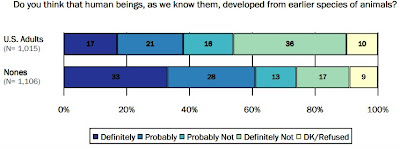What do these people actually believe? Are most of them atheists? The answers are in the following detailed report: American Nones: The Profile of the No Religion Population.
What does this group think about evolution? The results are surprising.

Among the general public, only 38% think that evolution is definitely or probably correct. This number only rises to 61% among the nones! 17% of them are certain that humans didn't evolve. What in the world are they thinking?
Well, it turns out that the "no religion" category hides a great deal of diversity. When asked about the existence of God you get the following responses ...

More than half of them believe in some sort of supernatural being and only a small percentage qualify as atheists.
 An even smaller percentage will actually admit to being an atheist or an agnostic in spite of the fact that their answers to other questions identify them as atheists or agnostics. The "belonging" category refers to the answer to the question, "What is your religion, if any?" It's a way of allowing respondants to self-identify as atheists or agnostics.
An even smaller percentage will actually admit to being an atheist or an agnostic in spite of the fact that their answers to other questions identify them as atheists or agnostics. The "belonging" category refers to the answer to the question, "What is your religion, if any?" It's a way of allowing respondants to self-identify as atheists or agnostics. As you can see from the data, almost 90% prefer to identify themselves as having no religion rather than label themselves atheists or agnostics. This group includes, of course, those people who really are religious but just don't belong to a particular religious group.
We conclude from this data that about 12% of Americans don't believe in God—or at least have serious doubts—but only 2% admit it. This number is considerably higher in other industrialized nations according to adherents.com. Atheists, agnostics, and non-believers probably represent a majority of the population in Sweden, Denmark, Norway, Japan, and the Czech Republic and they are close to a majority in Finland, France, South Korea, Estonia, and Germany.
[Hat Tip: Razib Khan]















